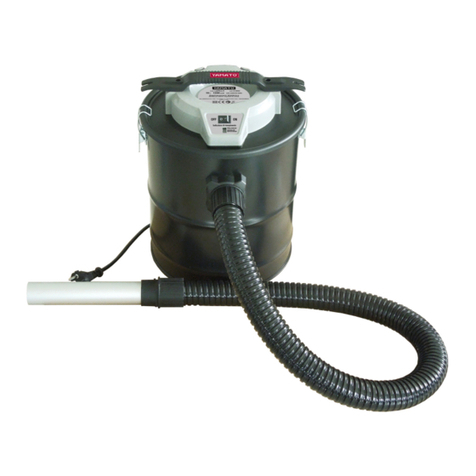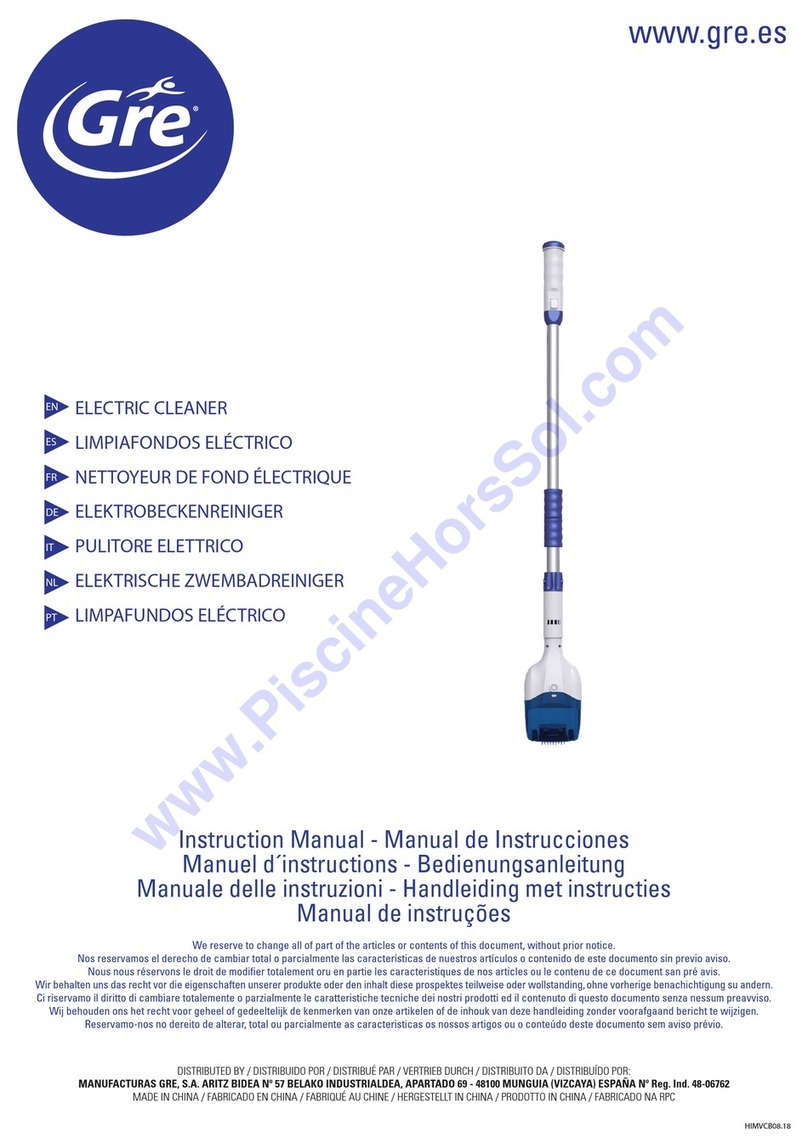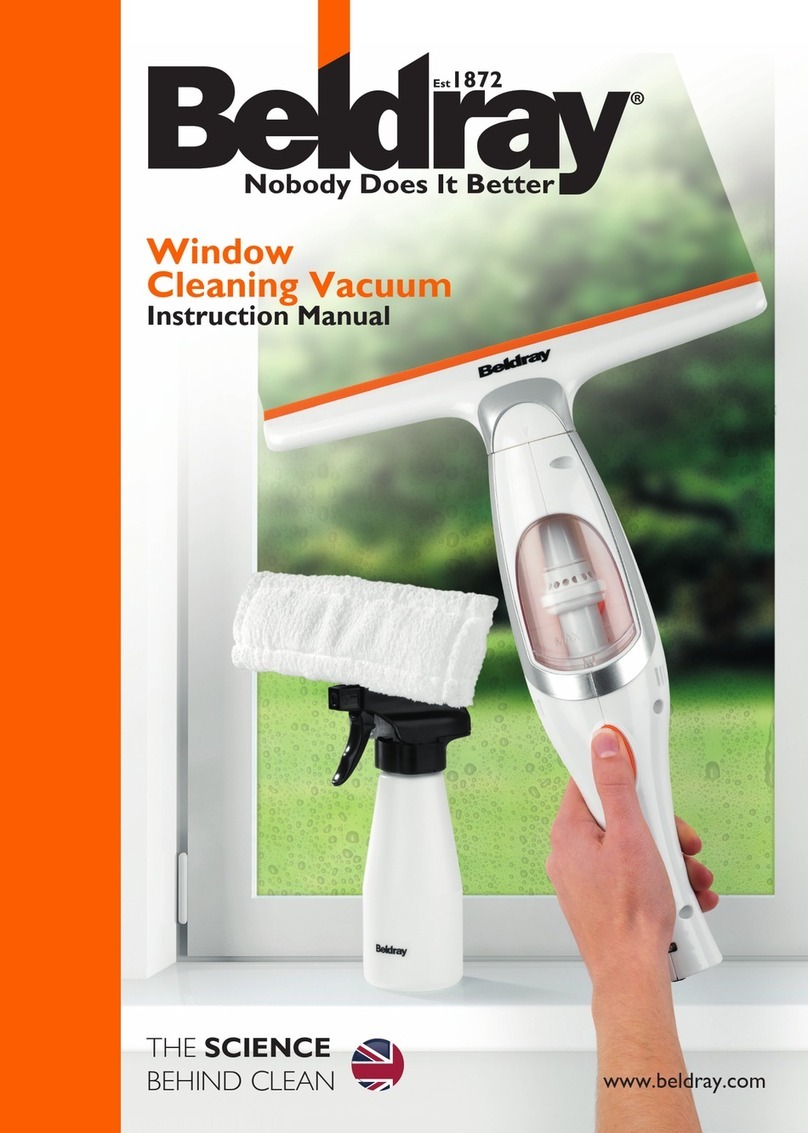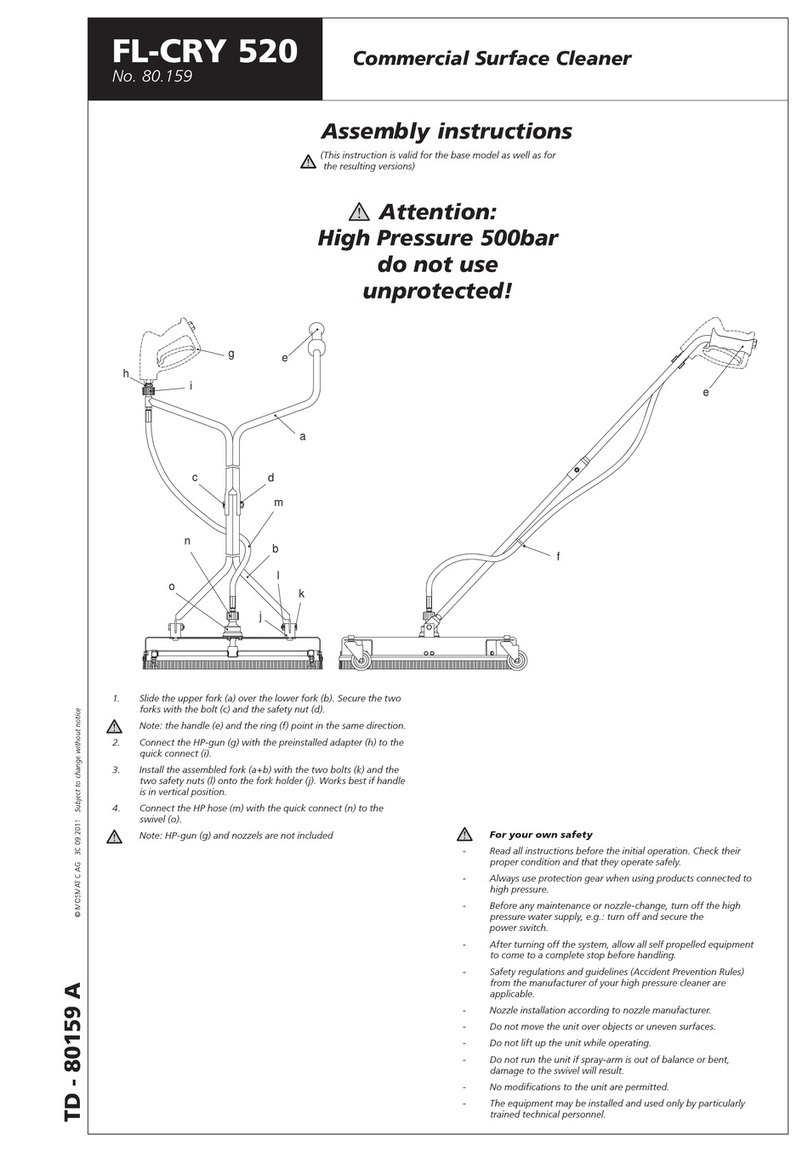Yamato PDC610 User manual

Plasma Dry Cleaner
PDC610
Instruction Manual
First version
Thank you for your selecting Yamato Scientific’s “plasma dry
cleaner”.
To ensure proper handling of the machine, please read this
instruction manual and the warranty thoroughly. After
reading the manual, please keep it together with the warranty
in a safe place where it is available any time necessary.
WARNING: Prior to using the product, carefully read all
warning instructions contained in the manual and
understand them fully.
YAMATO SCIENTIFIC CO., LTD.
This paper has been printed on recycled paper.

Contents
1. Safety precautions...............................................................1
DESCRIPTION OF WARNING SYMBOLS ..........................................................................1
ALIST OF SYMBOLS....................................................................................................2
WARNING AND CAUTION..............................................................................................3
2. Before operating the unit ....................................................4
PRECAUTIONS FOR INSTALLATION ................................................................................4
3. MAIN APPLICATIONS...........................................................5
APPLICATIONS............................................................................................................5
4. COMPONENTS AND FUNCTIONS.......................................6
MAIN UNIT .................................................................................................................6
BACK OF THE MAIN UNIT .............................................................................................7
5. INSTALLATION METHOD.....................................................8
REQUIRED EQUIPMENT /METHODS TO CONNECT CABLES AND TUBES ............................8
6. INSTALLING ELECTRODES ................................................9
LIST OF ELECTRODE RELATED ACCESSORIES.................................................................9
INTERNAL STRUCTURE AND OF THE CHAMBER AND PARTS NAMES..................................10
WHEN ONE-STAGE ELECTRODE IS USED......................................................................11
WHEN 2-STAGE ELECTRODE IS USED(INSTALLATION OF ELECTRODES)......................12
WHEN 2-STAGE ELECTRODE IS USED(RIE MODE)....................................................13
WHEN 2-STAGE ELECTRODE IS USED(DP MODE).....................................................14
WHEN 3-STAGE ELECTRODE IS USED(INSTALLATION OF ELECTRODES)......................15
WHEN 3-STAGE ELECTRODE IS USED(RIE MODE)....................................................16
WHEN 3-STAGE ELECTRODE IS USED(DP MODE).....................................................17
7. RUNNING PROCEDURE ....................................................18
OPERATION IN AUTO RUN..........................................................................................18
RUNNING PROCEDURE..............................................................................................19
TOUCH PANEL OPERATIONS ......................................................................................22
8. PRECAUTIONS FOR HANDLING ......................................30
WARNING AND CAUTION..................................................................................30
9. MAINTENANCE...................................................................31
DAILY INSPECTION ....................................................................................................31
PERIODIC INSPECTION...............................................................................................32
10. ALARMS AND CORRECTIVE ACTIONS..........................33
ALARMS AND CORRECTIVE ACTIONS ..........................................................................33
OPERATING PROCEDURES FOR AUTO TUNING ADJUSTING SWITCH...............................34
11. AFTER-SALE SERVICE AND WARRANTY......................35
REQUEST FOR REPAIR ..............................................................................................35

12. SPECIFICATIONS .............................................................36
SPECIFICATIONS .................................................................................................36
ACCESSORY LIST ......................................................................................................36
13.WIRING DIAGRAM.............................................................37
14.Piping Diagram..................................................................39
15.Parts List............................................................................40
16. DISPOSAL.........................................................................41
PRECAUTIONS FOR DISPOSAL....................................................................................41
17. LIST OF HAZARDOUS SUBSTANCES............................42

1
1. Safety precautions
Description of Warning Symbols
About pictograms
A variety of pictograms are indicated in this operating instruction and on
products for safe operation. Possible results from improper operation
ignoring them are as follows.
Be sure to fully understand the descriptions below before proceeding to the
text.
Warning
Caution
Indicates a situation which may result in minor injury (Note 2) and
property damages (Note 3.)
(Note 1)Serious injury means a wound, an electrical shock, a bone fracture or intoxication that may
leave after effects or require hospitalization or outpatient visits for a long time.
(Note 2)Minor injury means a wound or an electrical shock that does not require hospitalization or
outpatient visits for a long time.
(Note 3)Property damage means damage to facilities, devices and buildings or other properties.
Meanings of pictograms
This pictogram indicates a matter that encourages the user to adhere to warning
(“caution”included).
Specific description of warning is indicated near this pictogram.
This pictogram indicates prohibitions
Specific prohibition is indicated near this pictogram.
This pictogram indicates matters that the user must perform
Specific instruction is indicated near this pictogram.
Indicates a situation which may result in death or serious injury (Note 1.)

2
1. Safety precautions
A List of Symbols
Warning
General warnings
Danger!: High
voltage
Danger!: High
temperature
Danger!: Moving
part
Danger!: Hazard
of explosion
Caution
General cautions
Electrical shock!
Burning!
Prohibitions
General bans
Do not
disassemble
Do not touch
Compulsions
General
compulsions
Connect ground
wire
Install levelly
Pulloutthepower
plug
Periodical
inspection

3
1. Safety precautions
Warning and Caution
Warning
1. Never use the machine in atmosphere containing ignitable and explosive gases.
Never use the machine in atmosphere containing ignitable and explosive gases. The ma-
chine is not of explosion-proof construction. Turning on and off the switches and operating
the machine will produce sparks, which may become a cause of a fire or explosion. (See
“List of Hazardous Substances.”)
2. Never use explosive and flammable substances.
Never use explosive and flammable substances and substances containing such sub-
stances. The machine is not equipped with safety features against such substances. They
are a cause of explosion and fire.
3. Never use the machine in abnormal conditions.
If you notice smoke, offensive odor or other problems, immediately turn off the circuit breaker
of the machine and also turn off the power of the distribution panel on the building side. They
are a cause of a fire and electric shock.
4. Never disassemble or modify the machine.
The machine must not be disassembled or modified by the user. Unauthorized disassembly
and modification are a cause of failure, fire, electric shock and other accidents.
5. Handling of the power cords.
Do not use bundled power cords. Such a way of use may cause the cords to overheat to
cause a fire.
Do not machine power cords or bend, twist or pull them by undue force. Hazard of a fire and
electric shock.
Do not damage power cords by for example placing them under a desk or chair or clamping
them by devices. Hazard of a fire and electric shock.
Do not bring power cords near heating devices such as a heater. The coating of the cords
will be burnt to cause a fire or electric shock.
If a power cord is damaged (core wires exposed or broken), immediately turn off the power
of the machine and also turn off the source power supply. Then request the dealer for
replacement of the cord. If such damaged cords are used, a fire or electric shock may result.
Use only one power cord. Never join two or more power cords.
Depending on the connecting method, screws may be loosened and cause a fire or an
electrical shock.
6. Be sure to use the specified reaction gas.
Be sure to use the specified processing gas (argon gas, oxygen optional). If other gas is
used, the actual flow rate becomes different from the indicated flow rate. Also other problems
such as damage to products and insufficient cleaning may happen.

4
2. Before operating the unit
Precautions for Installation
Warning
1. Be sure to connect the ground wire.
・To prevent electric shock accidents due to fault current, be sure to connect the ground
wire to the ground terminal on the building side. This machine falls in the category of
Class D Ground Work.
・Never connect the ground wire to a gas pipe, water pipe, ground wire of a telephone or
lightning conductor. Hazard of a fire and electric shock.
2. Select a suitable installation site.
Do not install the machine in the following places:
・An unstable place.
・A place where flammable or corrosive gas is produced.
・A place where ambient temperature rises above 35℃.
・A place where temperature changes largely.
・A place filled with dust or a humid place.
・A place under direct sunlight.
・A place that is subjected to vibrations.
3. Install the machine on a level foundation.
Install the machine on a level foundation. If the machine is not in contact with the floor
uniformly, vibration and noise may be produced. Also unexpected troubles or failures may
occur.
4. Use a suitable distribution panel.
Use a distribution panel that is suitable for the electric rating of the machine.
Electric rating: 3-phase, 200 VAC (Differ depending on the region. See page 19.), 15 A,
50/60 Hz
If the capacity is insufficient or the machine is used on a line to which other equipment is
connected, the machine may not function properly or the circuit breaker in the distribution
panel may operate.

5
3. MAIN APPLICATIONS
Applications
Applications
The unit is used to plasma-process work pieces to modify their surfaces or to clean them.
The unit has two modes (RIE and DP) to support various applications.
Application of the RIE mode
This mode is used to clean objects whose soil contains inorganic matters as well as organic ones,
or to modify surfaces.
When Ar gas plasma process is performed in the RIE mode, the surface of a work piece put on the
electrode surface will be cleaned with physical action caused by ions accelerated toward it and hit
against it, which is the main feature of this mode. (Because the work piece on the electrode is
processed with Ar ions hit from the above, only its top surface will be processed. The range in
whichAr gas is accelerated is several millimeters above the electrode.)
<Examples of applications>
●Improving adhesiveness and
surface modification of different
materials
●Light etching process
●Preprocessing of implementation
board bonding
●Preprocessing of plastic package
●Preprocessing of print board
plating
●Processing of part for LED
related markets
●Cleaning of electronic parts
●Cleaning of optical parts, dies,
machine parts and other
precision parts
●Modification of fluoride or other resin surfaces
Application of the DP mode
This mode is used to clean objects whose soil contains organic ones, or to modify surfaces.
When O2gas plasma process is conducted in the DP mode, O2plasma acts to organic matters on
the surface of the object, then those organic matters and O2radicals will be converted chemically in
vacuum to clean the surface. Because O2ions and O2radicals in the plasma spread
non-directionally between the electrodes in the DP mode, the whole surface of the work piece
between the electrodes and that contacts the plasma will be processed.
<Examples of applications>
●Improving adhesiveness and surface
modification of different materials
●Light ashing process
●Preprocessing of plastic package
●Preprocessing of print board plating
●Cleaning of electronic parts
●Cleaning of optical parts, dies,
machine parts and other
precision parts
●Peeling off of resists or removing
residue after wetting process
●Modification of resin surfaces
Ar ion
Matching
unit
RF
Power
supply
Object
Electrons
Ar ion
Object
Electrons
O2ion
O2radicals
Matching
unit
RF
Power
supply
Object (organic)
Electron
CO2molecule
O2molecule
O2ion
O2radicals
Object(organic)
Electron
CO2molecule
O2molecule

6
4. COMPONENTS AND FUNCTIONS
Main Unit
Front of the machine
①
Door
:This door is manually opened sideways.
②
Grip
:Used to open and close the door.
③
Check window
:This window is used to check plasma status.
④
Touch panel
:Used to operate various keys and show various information.
⑤
Operation power switch
:When this button is pressed, electricity is applied to the touch
panel and other parts of the machine to set the machine ready
to run.
⑥
Emergency stop switch
:Press this button when an emergency situation occurs. When
this button is pressed, the RF power, vacuum pump and opera-
tion panel power are turned off. To reset the button, turn it in
the arrow direction.
⑦
Earth leakage breaker
:When this breaker is turned on, electricity is applied to the
machine. If leakage exceeding 30 mAor overcurrent exceeding
16 A flows, it cuts off the current to protect the machine.
⑦-1
Test button
:Use this during
periodic inspections to
check if the earth
leakage breaker is
functioning properly.
⑦-2
Leakage
indicator
:When leakage occurs,
this button pops out.
①
③
②
④⑥⑤⑦
⑦-1 ⑦-2

7
4. COMPONENTS AND FUNCTIONS
Back of the Main Unit
Back of the main unit
⑧
Connector for power cord
:Connect this to the distribution panel on the building side. (A3-m
cord is attached for connection.)
⑨
Connector for vacuum
pump
:Connect the cable from the vacuum pump.
⑩
Ground terminal
:Use this to ground the machine by a line other than the attached
power cord or to ground measuring instruments.
⑪
Vacuum nozzle
:Connect the vacuum pump with the attached flexible tube.
⑫
Nitrogen (N2)gas
connector
:Connect piping from the N2gas cylinder. Adjust the pressure to
the range of 0.2 MPa to 0.3 MPa.
⑬
Argon (Ar) gas connector
:Connect piping from the Ar gas cylinder. Adjust the pressure to
the range of 0.15 MPa to 0.2 MPa.
⑭
Oxygen (O2) gas connector
:Connect piping from the O2gas cylinder. Adjust the pressure to
the range of 0.15 MPa to 0.2 MPa
⑮
Cooling fan
:Cools the inside of the enclosure. Provide a space of more than
10 cm around the enclosure so that the airflow will not be
disturbed.
⑧⑨⑩
⑮
⑪
⑬
⑭
⑫

8
5. INSTALLATION METHOD
Required Equipment / Methods to Connect Cables and Tubes
1) Gas piping
Gas piping up to the machine must be provided by the user. Connect piping to the gas supply ports
on the back of the machine and supply gases at the specified pressures. Use the included 1/4-inch
flare-less joints (attached in the coupling portion on rear side) the to connect the machine and the
piping and tighten them as described below.
(1)Gas supply nozzle locations and supply pressures
(2)Flare-less joint tightening procedure
①Pass a nut, back ferrule and front ferrule(attached in the coupling portion on rear side) to the
pipe.
②Insert the pipe to the joint to the specified depth.
③Tighten the nut strongly with fingers.
Exercise care so that the pipe will not be bent to become resistance.
④Using a wrench, tighten the nut one turn and a quarter from the finger-tightened point.
The left side figure shows the correctly tightened pipe.
2)Electricity connection and supply
The wiring from the building side distribution panel to the machine must be laid by the user. The
machine requires an electric capacity of 3-phase, 200 VAC (differ depending on the region. See
page 19), 15 A or more. Connect the red, white and black cables to the R, S and T phases
respectively. The green cable is for grounding. Connect it to the terminal of Class D
Ground Work.
3)Vacuum pump
Install the vacuum pump by the following procedure:
①Referring to the attached vacuum pump instruction manual, fill oil to the vacuum pump.
②Place the vacuum pump on a horizontal floor or sturdy table.
③Connect the power cable for vacuum pump to the vacuum pump connector of the machine.
④Install the oil mist filter on the vacuum pump using a clamp.
⑤Cap the suction port of the vacuum pump and turn on the switch on the operation panel
momentarily. When the cap is sucked, the pump is running in the correct direction. If the cap is
blown out, it is running in a reverse direction.
⑥If the pump runs in a reverse direction, exchange two out of three power cables connected to
the distribution panel.
⑦Connect the nozzle and the vacuum pump with the included flexible tube and NW25 clamp.
Oxygen gas(O2)
Supply pressure=0.2MPa
Argon gas(Ar)
Supply pressure=0.2MPa
Nitrogen gas(N2)
Supply pressure=0.2MPa
Apply the end face of the
pipe here.
Nut
Back ferrule
Front ferrule
Nut

9
6. INSTALLING ELECTRODES
List of electrode related accessories
①Lower electrode x 1 ②Lower electrode fixing clamp
③Upper electrode x 1 ④Upper electrode fixing clamp
⑤Shelf board electrode x 2 ⑥Feed through connecting plate
(used for three-stage configuration)
⑩RIE fixing clamp for
shelf board
electrode (used for
3-stage
configuration)
⑨DP fixing clamp for
shelf board
electrode
(used for 3-stage
configuration)
⑧RIE fixing clamp for
shelf board electrode
(used for 2-stage
configuration)
⑦DP fixing clamp
for shelf board
electrode (used
for 2-stage
configuration)

10
6. INSTALLING ELECTRODES
Internal structure and of the chamber and parts names
①
Feed through
:High frequency wave is supplied here.
②
Shelf peg
:Cable from the vacuum pump is connected here.
③
Shelf board electrode slide
pin
:This is used when earthing from a source other than the included
power cord or for earthing measuring devices.
④
Upper electrode slide rail
:Connected to the vacuum pump with the included flexible tube.
①Feed through 2 points
②Shelf pegs 4 points
④Upper electrode slide rail 2 points
③Shelf board electrode slide pins 8
pins included

11
6. INSTALLING ELECTRODES
When one-stage electrode is used
Installing electrodes
ⅰ) Insert the upper electrode into the slide rail.
ⅱ) Install the lower electrode onto the bottom of the chamber.
≪RIE mode≫
※Connect the feed through and the lower electrode with the lower electrode fixing clamp. (Flat head
screw M4×5, truss screws M4×6)
At this time, install M4×6 truss screws (included) to the screw points of the upper feed through that is
not used.
≪DP mode≫
※Connect the feed through and the upper electrode with the upper electrode fixing clamp. (Truss
screw M4×6)
At this time, install M4×6 truss screws (included) to the screw points of the lower feed through that is
not used.
Installation
position of lower
electrode fixing
clamp
Lower electrode
fixing clamp
Installation
position of upper
electrode fixing
clamp
Upper electrode
fixing clamp

12
6. INSTALLING ELECTRODES
When 2-stage electrode is used(installation of electrodes)
ⅰ) Insert the upper electrode into the slide rail.
ⅱ) Install the lower electrode onto the bottom of the chamber.
ⅲ) Install shelf board electrode slide pins into the screw holes in the middle of each of shelf pegs. (CAP
bolts M4×10) (Right/left Four points in total)

13
6. INSTALLING ELECTRODES
When 2-stage electrode is used(RIE mode)
①Connect the feed through and the lower electrode with the lower electrode fixing clamp.(Flat head
screws M4×5, truss screws M4×6)
②Install the RIE fixing clamp for shelf board electrode at the point of the shelf board electrode shown in
the diagram below. (Flat head screw M4×5)
③Insert the shelf board electrode into the chamber and connect the feed through and the RIE fixing
clamp for the shelf board electrode. (Truss screw M4×6)
Installation position
of lower electrode
fixing clamp
Lower electrode
fixing clamp

14
6. INSTALLING ELECTRODES
When 2-stage electrode is used(DP mode)
①Connect the feed through and the upper electrode with the upper electrode fixing clamp. (Truss
screws M4×6)
②Install the DP fixing clamp for shelf board electrode at the point of the shelf board electrode shown in
the diagram below. (Truss screw M4×6)
③Insert the shelf board electrode into the chamber and connect the feed through and the RIE fixing
clamp for the shelf board electrode. (Truss screws M4×6)
Installation
position of upper
electrode fixing
clamp
Upper electrode
fixing clamp

15
6. INSTALLING ELECTRODES
When 3-stage electrode is used(installation of electrodes)
ⅰ) Insert the upper electrode into the slide rail.
ⅱ) Install the lower electrode onto the bottom of the chamber.
ⅲ) Install shelf board electrode slide pins into upper and lower screw holes on each of shelf pegs.(CAP
bolts M4×10)
At this time, install truss screws (M4×6) to those unused screw holes.
(Right/left Eight points in total)

16
6. INSTALLING ELECTRODES
When 3-stage electrode is used(RIE mode)
≪RIE mode≫
①Install the lower electrode fixing clamp to the lower electrode. (Flat head screws M4×5)
②Tighten the feed through connecting plate and the lower electrode fixing clamp altogether to the feed
through. (Truss screws M4×8)
③Install the RIE fixing clamp for shelf board electrode at the point of the shelf board electrode shown in
the diagram below.
④Insert the shelf board electrode into the chamber and connect it to the feed through. (Truss screws
M4×6, M4×8)
Feed through
connecting plate
Lower electrode fixing
clamp
Truss screws M4×8
Tighten together with the feed
through connecting plate
Truss screws M4×6
Flat head
screws M4×5
Truss screws M4×8
Tighten together with the
feed through connecting
plate

17
6. INSTALLING ELECTRODES
When 3-stage electrode is used(DP mode)
≪DP mode≫
①Install the upper electrode fixing clamp to the upper electrode. (Truss screws M4×6)
②Tighten the feed through connecting plate and the upper electrode fixing clamp altogether to the feed
through.(Truss screws M4×8)
③Install the DP fixing clamp for shelf board electrode at the point of the shelf board electrode shown in
the diagram below. (Truss screws M4×6)
④Insert the shelf board electrode into the chamber and connect it to the feed through. (Truss screws
M4×6, M4×8)
Truss screws M4×8
Tighten together with the
feed through connecting
plate
Feed through connecting plate
Upper electrode fixing clamp
Truss screws
M4×6
Truss screws M4×8
Tighten together with the
feed through connecting
plate
Truss screws M4×6
Table of contents
Other Yamato Ultrasonic Jewelry Cleaner manuals
Popular Ultrasonic Jewelry Cleaner manuals by other brands
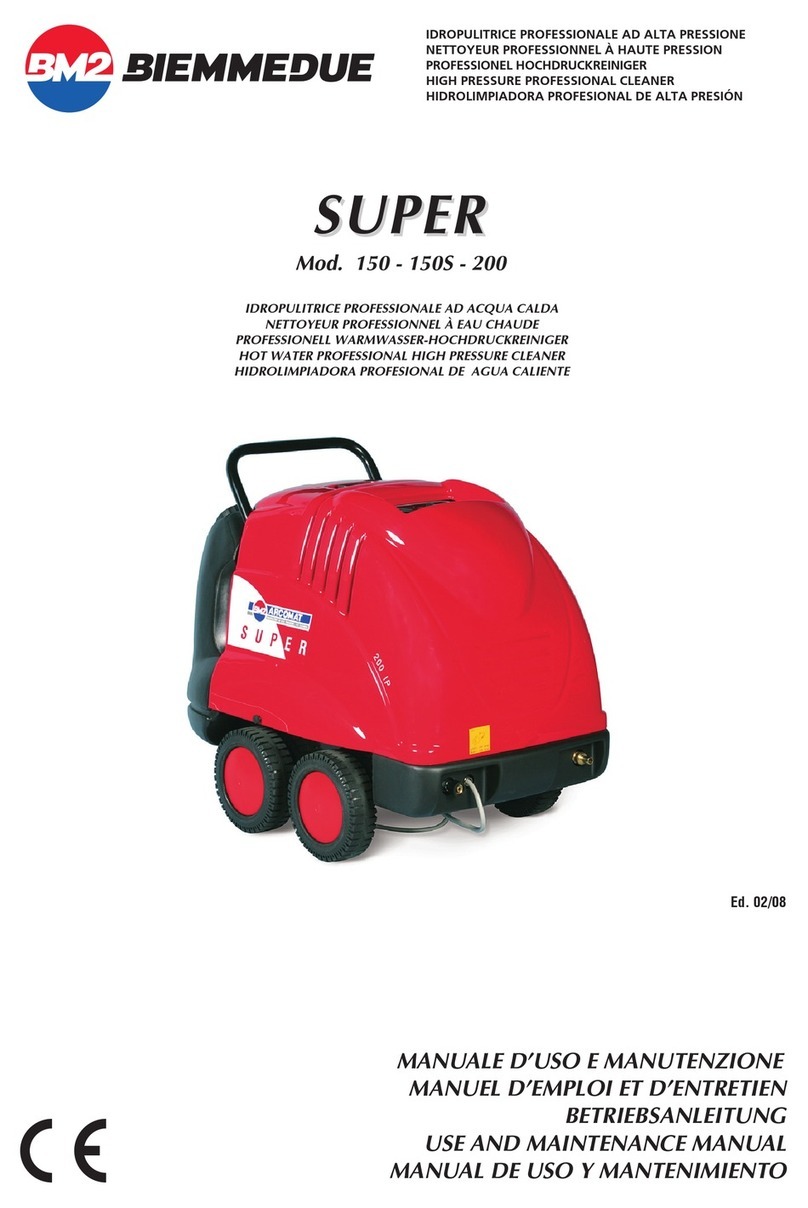
BM2 BIEMMEDUE
BM2 BIEMMEDUE SUPER 150 Use and maintenance manual
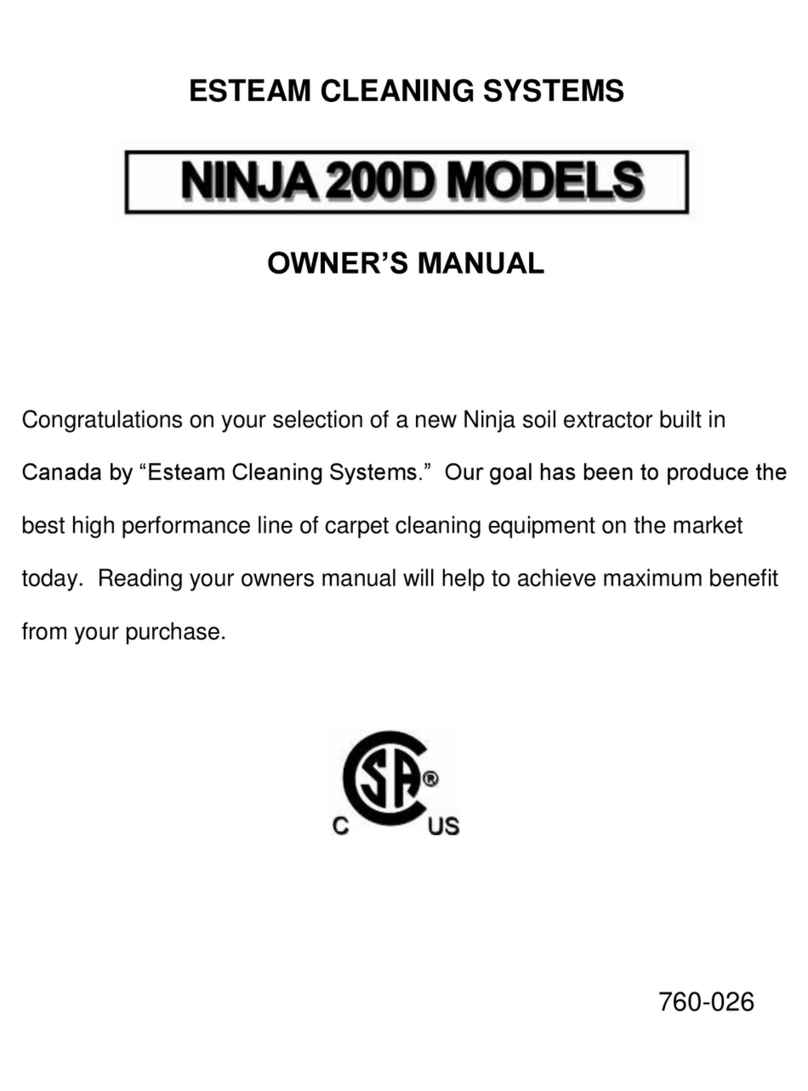
Esteam
Esteam NJA200D owner's manual

pullman Ermator
pullman Ermator T4000 operating instructions
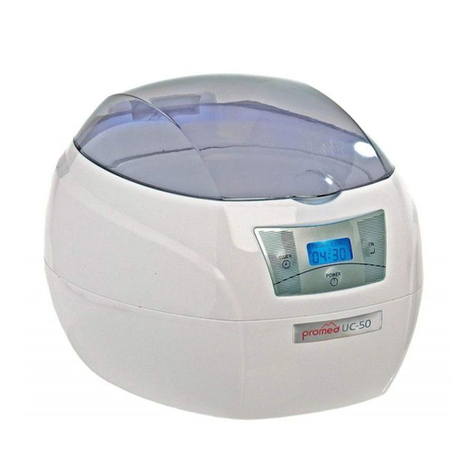
ProMed
ProMed UC-50 Instruction leaflet

pullman Ermator
pullman Ermator T8600F operating instructions

Ribimex
Ribimex PRCEN001/1530 Instruction manual and maintenance
